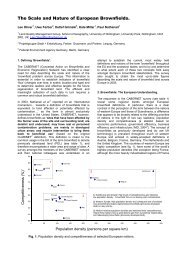Sustainable Brownfield Regeneration: CABERNET Network Report
Sustainable Brownfield Regeneration: CABERNET Network Report
Sustainable Brownfield Regeneration: CABERNET Network Report
You also want an ePaper? Increase the reach of your titles
YUMPU automatically turns print PDFs into web optimized ePapers that Google loves.
<strong>Sustainable</strong> <strong>Brownfield</strong> <strong>Regeneration</strong>:<br />
<strong>CABERNET</strong> <strong>Network</strong> <strong>Report</strong><br />
8<br />
EU Policy Recommendations on<br />
<strong>Brownfield</strong> Redevelopment<br />
8<br />
The international competitiveness of Europe’s towns and cities is to no small degree<br />
influenced by the extent to which they offer an attractive and desirable living and<br />
working environment – and so are capable of attracting and retaining residents and<br />
investment. Their attractiveness is, in turn, influenced by the ability of these towns and<br />
cities to re-invent themselves and their built assets in the face of economic, social and<br />
technological change.<br />
The extent to which brownfield land becomes re-used rather than remaining vacant<br />
or derelict is a key indicator of this ability of cities to re-invent themselves and a major<br />
contributor to the achievement of sustainable urban environments. Failure of such land<br />
to be readily re-used is both a lost opportunity to achieve sustainable development<br />
of Europe’s towns and cities, and creates an added burden on achieving desirable and<br />
competitive cities to the extent that it blights the local area and its community.<br />
It becomes obvious that the reuse of derelict sites plays a contribution to European<br />
Cities realising the “Lisbon Strategy”: If the EU is to be “the most competitive and<br />
dynamic knowledge-based economy in the world by the year of 2010”, then the EU has to<br />
offer high quality of life in its urban context.<br />
A wide range of EU policies and initiatives influence the pace at which brownfield land<br />
becomes re-used or, conversely, remains as vacant or derelict land and buildings further<br />
degrading its surroundings. In addition, given the contribution that the better re-use<br />
of brownfield land makes to the achievement of competitive and sustainable cities,<br />
the successful re-use of brownfield land can positively contribute to the underlying<br />
objectives of many of the EU policies and initiatives.<br />
In other words, a ‘brownfield land dimension’ is critical to the pursuit and attainment<br />
of many aspects of the EU’s structural change, cohesiveness and competitiveness<br />
agenda. The various links between brownfield land and EU policies and initiatives<br />
are set out, in turn, below, together with specific recommendations to improve the<br />
synergy with brownfield land matters.<br />
There is a shared desire within the brownfield Redevelopment sector for more clearly<br />
articulated, consistent and practical policies and regulations on land reuse from the EC.<br />
Generally, the policy and legal frameworks used for managing brownfield sites are those<br />
associated with ‘contaminated land’, although this does not adequately encapsulate<br />
the range of issues related to <strong>Brownfield</strong> Redevelopment (Grimski and Ferber, 2001⁷²).<br />
Currently, a large number of EC activities impinge on brownfield Redevelopment, and<br />
determining the EC’s position requires engaging with numerous diverse policy fields.<br />
Yet a coherent approach to brownfield <strong>Regeneration</strong> is a prerequisite to successful<br />
environmental, spatial, urban and economic development in Europe. Without such<br />
⁷²Grimski D and Ferber U (2001) Urban <strong>Brownfield</strong>s in Europe, Land Contamination and Reclamation, Vol 9 No 1,<br />
pp. 143-148<br />
121






